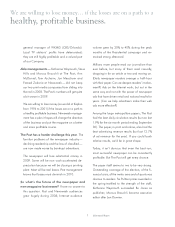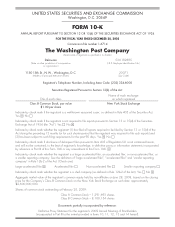Washington Post 2008 Annual Report Download - page 19
Download and view the complete annual report
Please find page 19 of the 2008 Washington Post annual report below. You can navigate through the pages in the report by either clicking on the pages listed below, or by using the keyword search tool below to find specific information within the annual report.qualify for that exemption. Monthly subscription rates charged for the basic tier of cable service, as well as rates charged
for equipment rentals and service calls, for many of our cable systems remain subject to regulation by local franchise
authorities in accordance with FCC rules. However, rates charged by cable television systems for tiers of service other
than the basic tier—for pay-per-view and per-channel premium program services, for digital video, cable modem services
and digital telephone—and for advertising are all currently exempt from regulation.
“Must-Carry” and Retransmission Consent. Under the “must-carry” requirements of the 1992 Cable Act, a commercial
television broadcast station may, subject to certain limitations, insist on carriage of its signal on cable systems located
within the station’s market area. Similarly, a non-commercial public station may insist on carriage of its signal on cable
systems located either within the station’s predicted Grade B signal contour or within 50 miles of a reference point in a
station’s community designated by the FCC. As a result of these obligations, certain of the Company’s cable systems have
had to carry broadcast stations that they might not otherwise have elected to carry, and the freedom the Company’s
systems would otherwise have to drop signals previously carried has been reduced.
At three-year intervals beginning in October 1993, commercial broadcasters have had the right to forego must-carry
rights and insist instead that their signals not be carried by cable systems without their prior consent. The next three-year
election cycle begins October 1, 2011, with the elections effective January 1, 2012 through December 31, 2014.
Congress has barred broadcasters from entering into exclusive retransmission consent agreements through the end of
2010. In some cases, the Company has been required to provide consideration to broadcasters to obtain retransmission
consent, such as commitments to carry other program services offered by a station or an affiliated company, to purchase
advertising on a station or to provide advertising availabilities on cable to a station. A Notice of Proposed Rulemaking
issued by the FCC in 2007 that raises, among other things, the issue of whether a broadcaster should be allowed to
require carriage of affiliated programming as a condition of obtaining retransmission consent remains pending.
Communications Act provisions that require cable operators and broadcasters to engage in “good faith” negotiations
over retransmission consent and bar exclusive retransmission consent agreements are scheduled to expire at the end of
2009 unless Congress acts to extend them or make them permanent.
Digital Television (“DTV”). The FCC has determined that until the completion of the transition of broadcast television
from analog transmissions to digital transmissions (scheduled to occur on June 12, 2009), only television stations
broadcasting in a DTV-only mode can require local cable systems to carry their DTV signals, and that if a DTV signal
contains multiple video streams, only the “primary” stream of video, as designated by the station, is required to be
carried. In December 2007, the FCC issued an order generally requiring cable operators to ensure that following the
digital transition deadline, all local must-carry broadcast stations are “viewable” by all subscribers, either by providing
customers with both a digital and down-converted analog version of such stations (and in some instances also providing a
standard-definition digital signal) or by deploying an “all-digital” system platform prior to the transition deadline.
Moreover, where a must-carry broadcast station’s signal is transmitted in high-definition television (“HDTV”) format, cable
operators generally will be required to carry the signal in HDTV format . In September 2008, the FCC modified these
requirements somewhat, clarifying that mixed analog/digital cable systems did not have to carry a standard-definition
digital signal in addition to a down-converted analog signal and that smaller systems (i.e., systems with 552 MHz
capacity or less and systems with under 2,500 subscribers not affiliated with the top two cable companies) were exempt
from providing an HD signal in addition to a down-converted analog signal. While these exemptions provide some relief,
satisfaction of the generally applicable obligation to carry the analog and the standard-definition and/or the HDTV format
signal of local broadcast signals could result in the Company’s cable systems being required to delete some existing
programming to make room for all of the video streams included in broadcasters’ DTV signals. Satisfaction of these
requirements by converting to all-digital platforms in our systems would require substantial capital expenditures, including
provisioning households using analog television receivers with set-top boxes capable of down-converting the digital
broadcast signals. In addition, the FCC is considering expanded must-carry requirements for Class A low-power television
stations after the digital transition deadline that could have similar adverse effects on Cable ONE’s operations.
In anticipation of the broadcast television analog-to-digital transition scheduled to occur on June 12, 2009, the FCC has
implemented rules requiring cable operators to provide monthly consumer education notices to their subscribers about the
transition. The FCC’s Enforcement Bureau reportedly has been investigating cable operator compliance with these rules
and is recommending the imposition of fines on some operators for deficiencies in their compliance. To date, the
Company has not received any inquiries from the FCC regarding its compliance with these rules.
The FCC also has begun inquiries into the practices of certain cable operators that offer “switched digital video” service
or have “migrated” cable networks formerly available in analog format to digital format, potentially requiring subscribers
to obtain additional equipment in order to receive services previously available without such equipment. The Company
has not received any inquiries on such matters. In addition, both the FCC and the courts have been asked to address
2008 FORM 10-K 7
























